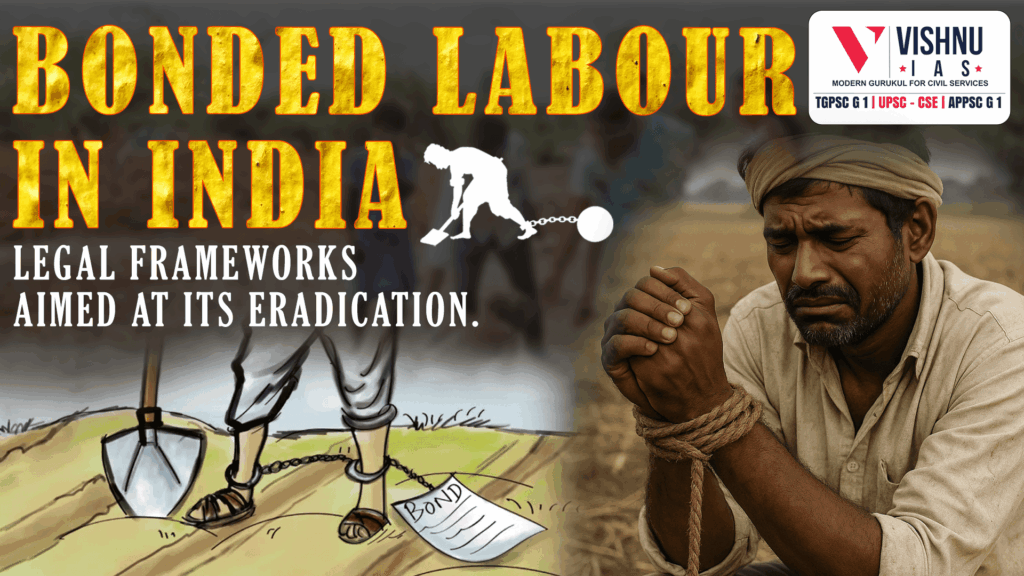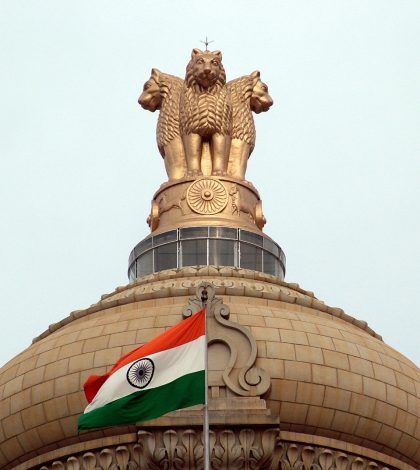Q. Examine the socio-economic factors that perpetuate bonded labour in India, despite legal frameworks aimed at its eradication.
Introduction:
- Bonded labour, also known as debt bondage, is a form of modern-day slavery where individuals are compelled to work to repay debts under exploitative conditions, often without clear terms or timelines. Despite the abolition of the bonded labour system in India through the Bonded Labour System (Abolition) Act, 1976, the practice persists.
- According to the 2023 Global Slavery Index, approximately 11 million people were living in modern slavery in India in 2021, the highest number globally. Furthermore, the 2024 Trafficking in Persons Report by the U.S. Department of State highlights that bonded labour remains widespread in India, with traffickers exploiting vulnerable populations through promises of advances and subsequent manipulation.
BODY
Economic Vulnerabilities and Structural Inequities
Poverty and Lack of Financial Alternatives
Economic desperation drives individuals to accept exploitative labour conditions. In the case of Mukesh Adivasi from Shivpuri, Madhya Pradesh, a ₹500 advance led him and his family into bonded labour in Karnataka, where they endured severe abuse.
Absence of accessible credit forces the poor to rely on informal lenders, often leading to debt traps. The Palamur debt bondage system in Andhra Pradesh exemplifies this, where workers depend on district leaders for loans and employment, perpetuating cycles of debt.
High-interest rates on informal loans exacerbate indebtedness, binding workers to their employers indefinitely.
Informal Labour Market and Lack of Regulation
The informal sector constitutes a major portion of India’s workforce. According to NSSO, out of 47 crore workers, only 8 crore are in the organized sector, leaving 39 crore unprotected.
Lack of formal contracts and weak regulation in sectors like brick kilns and agriculture lead to widespread abuse. K. Thenmozhi’s family was bound to a brick kiln in Bengaluru after accepting a ₹2,000 advance.
Climate change worsens labour conditions. Workers like Harilal Rajput in Bihar face extreme heat in kilns, impacting health and productivity.
Intergenerational Debt and Child Labour
Debt bondage spans generations, with children inheriting their parents’ obligations. A 2001 Physicians for Human Rights study found most child labourers worked to repay familial debts, earning as little as ₹18/day.
Educational deprivation is both cause and effect—children miss out on schooling, continuing the poverty cycle.
Caste-based discrimination further marginalizes communities. Dalit and Adivasi children are disproportionately represented in bonded labour statistics.
Gender Disparities and Exploitation
Women and girls face unique vulnerabilities. The Sumangali scheme in Tamil Nadu exploits girls for textile work to earn dowry money.
Sexual exploitation is common. The Jogini and Devadasi systems involve ritual dedication of girls, leading to lifelong abuse.
Stigma and lack of awareness prevent women from seeking help.
Legal Framework and Implementation Challenges
Inadequate Enforcement of Laws
The Bonded Labour System (Abolition) Act, 1976 exists, but is poorly enforced. Between 2016–2021, only 12,760 were rescued out of 1.84 crore estimated victims.
Corruption and bureaucratic indifference weaken enforcement.
Worker unawareness of rights exacerbates the problem.
Rehabilitation and Support Mechanisms
The Central Sector Scheme for Rehabilitation of Bonded Labourer–2021 offers ₹1–3 lakh depending on vulnerability.
Delays in disbursement and red tape hinder recovery, risking re-bondage.
Lack of holistic rehabilitation—mental health support, training, and job opportunities—makes reintegration difficult.
Judicial and Administrative Gaps
Overburdened courts prolong cases, deterring victims.
Poorly trained police lead to failed rescues and misidentification.
No centralized data system hinders policy design and accountability.
Societal Attitudes and Cultural Norms
Normalization of bonded labour in some communities allows the practice to persist.
Social ostracism of freed workers discourages others.
Patriarchal norms further entrench women in these exploitative systems.
Policy Interventions and Recommendations
Strengthening Legal and Institutional Frameworks
Amend laws to include stricter punishments and time-bound justice.
District-level task forces should monitor bonded labour actively.
Mainstream bonded labour issues into labour and welfare programs.
Enhancing Rehabilitation and Reintegration
Ensure timely disbursement of financial support post-rescue.
Comprehensive rehabilitation should include:
Vocational training
Education opportunities
Psychological counselling
Build local support systems to help workers reintegrate.
Promoting Awareness and Education
Mass awareness campaigns can inform vulnerable populations.
Integrate content into school curricula to prevent intergenerational continuation.
Engage influencers and community leaders to challenge cultural norms.
Collaborating with Civil Society and International Organizations
Partner with NGOs for grassroots rescue and rehabilitation.
Align national laws with ILO conventions and international standards.
Corporate social responsibility (CSR) should focus on ethical labour practices in supply chains.
Conclusion
Despite legal frameworks aimed at eradicating bonded labour, socio-economic vulnerabilities, systemic inequities, and implementation challenges perpetuate the practice in India. A multifaceted approach, encompassing legal reforms, robust rehabilitation mechanisms, societal awareness, and collaborative efforts, is imperative to address this deep-rooted issue.
Empowering vulnerable communities through education, financial inclusion, and social support can pave the way for a future free from bonded labour, upholding the dignity and rights of every worker.


